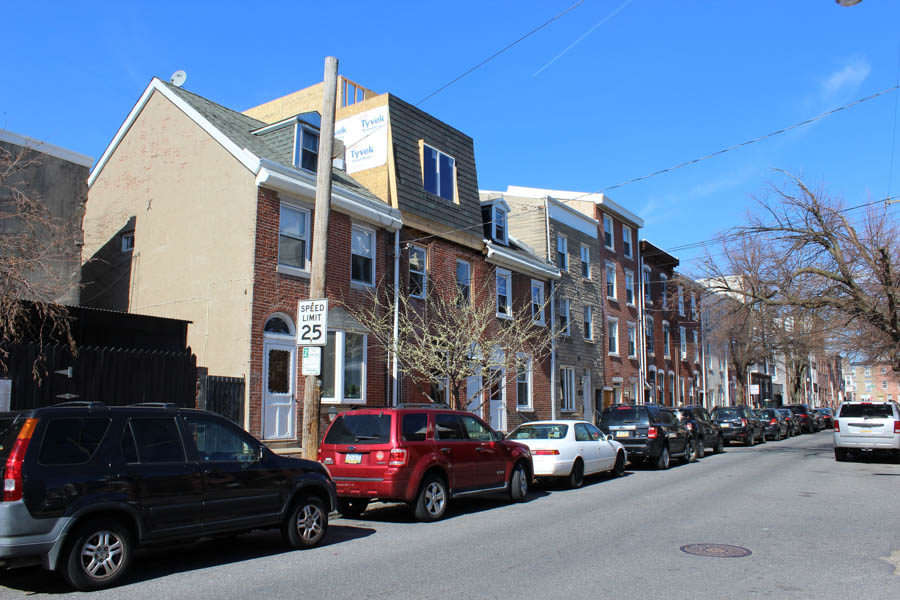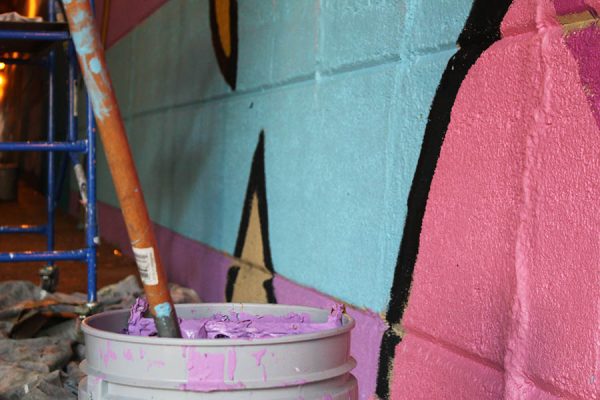When it Comes to Construction Woes, When’s it Time to Lawyer Up?
Hyperlocal journalism requires a boots-on-the-ground commitment to understand what’s really happening in the ‘hood. At the end of last October, we found ourselves on one of those foot-to-pavement excursions along E. Thompson Street near Frankford Avenue when we noticed a sign in the front window of one of the rowhouses.
The sign faced the street, stating that “211 E. Thompson St. Exposed My family to Asbestos.” Our journalistic senses began to tingle as we noticed the accused house seemed to be in a state of demolition. We were intrigued, so when we saw the neighbor sitting on her stoop shortly after, we inquired about her reasoning for placing the sign in the window.
At the time, PJ Thiede was more than happy to speak with us and she invited us to meet with her and Kevin Chaney, who was also living in the house at the time along with some small children. According to Thiede, the contractor working next door, Anthony Postiglione, had already worked on a house across from her. Thiede says that project caused a lot of dust to be let loose on the surrounding properties and when she saw the same type of project happening next door to her and her family, enough was enough.
“You could see the dust all the way up and down the street and the same thing happened across the street,” Thiede said. “That’s why I put up a sign up. I want everybody to know walking by.’”
Chaney, who has experience in the trades, was surprised at the demolition process.
“It just amazed me at the way these guys came in and did it,” Chaney said.
Thiede’s father and grandfather were metal workers and both died from mesothelioma. She worries for the health of the people doing the demolition. “They’ll come in and they’re being abused healthwise. No masks, no protection. They’re coming out and they’re coughing,” Thiede said.
Thiede has been living in the house since 1999, but according to her the house has been in her family since the 1950s. She says her grandfather was a tradesman and had done some home renovations to the house in the 1960s.
Thiede was quick to point out that she is glad that the neighborhood is changing. “I’ve seen the change and I’m for the improvement,” Thiede said. She pointed out that when she moved in one house on the block was abandoned and another was a “party house.”
According to Thiede, the changes next door have been a pain that she believes could have been avoided. Thiede says the demolition caused dust to settle all along E. Thompson Street.
She says she called the city, but every time an official showed up, the workers made the site presentable and went back to business as usual not long after. Thiede began to experience a rash and respiratory issues. “I got scared. I noticed red on my hands, a cough and phlegm,” Thiede said.
According to her the dust and noise were bad enough, but when the workers began punching holes through the wall with sledgehammers, she began to fear for her safety. Thiede describes the first time the workers broke through into one of her bedrooms.
“When they did the first [hole], I was yelling at them. I could see their eyes and they’re looking at me and still hitting it with the sledgehammer,” Thiede said. “They hit it a couple more times later, and then they were looking like, ‘Hey, there’s people there.’” According to her, there were a few more blows through the wall after the first.
Thiede says the dust from the broken walls covered the items that were in the room. She says the second time they came through the wall, a heated verbal dispute occurred between her and one of the workers. “The one guy came chasing at me [saying], ‘I’m gonna knock your head off,’” Thiede said. “He came up to my door, and the guys had to pull him off.”
Thiede filed a police report, accusing Postiglione’s crew of punching three holes in one of the bedroom’s walls. We reached out to public affairs for comment and they were able to reply with this description of the incident.
Here is the report:
The complainant reported on 10-12-16 that her neighbor was doing demolition work in his home, while knocking down an adjoining wall, the neighbor put three holes in the complainant’s bedroom wall. According to the report, the complainant can see right through to the neighbor’s bedroom. The complainant was advised to file a private criminal complaint.
The name on the incident report was Anthony Postiglione. Under his name on the sheet was a cell phone number. We called that number, but it went to voicemail and the voice on it was of a woman.
We saw Thiede on the sidewalk shortly after this interview and she described another incident that happened to her after the altercation with the workers. According to Thiede, she was about to exit her house through the front door, when she realized a red string had been tied to a planter across her front door.
It is unclear why the red string was placed across her door, but Thiede referred to it as a “voodoo” thing. Thiede showed us a picture of the red string, but we were unable to confirm the meaning of this; however, a red string has some significance as a form of protection in Kabballah and some other religions.
We reached out to Thiede and Chaney to see how their situation had evolved. However, we were unable to get a response from them before publishing this story. We still pass by their house and have noticed that the construction is ongoing five months later. When we spoke with them last, they were weighing their options. “I’ve had a couple guys come out, and everybody says don’t touch it,” Thiede said. “We’ve contacted a couple lawyers.”
Obtaining legal representation is the last option for many homeowners dealing with construction issues. So, before you hire a lawyer, it’s best to report your problem to your registered community organization (RCO). We reached out to Matt Ruben, president of the Northern Liberties Neighbors Association (NLNA), via email. He had some tips for dealing with contractors.
“Approach the crew and politely find out who’s in charge. Try to get the name and contact info for the general contractor, site manager, and/or developer or owner. They should have permits posted, or if not, then they must make them available upon request,” Ruben said
He added: “If they are excavating for a basement right next to your home, ask the general contractor or builder to come inside and take photos to document the condition of your basement walls — and take photos yourself. If cracks develop from their work, these photos will give you proof that the cracks were not already there before the work started.”
When developers build by-right, there are no zoning meetings. However, Ruben says it’s still a good idea to call the RCO since they are familiar with builders in the area and can often assist as a mediator between the contractor and the homeowner.
Ruben says the NLNA generally sticks to three principles when trying to mediate these kinds of construction-related disputes.
First off: “Connect the neighbor with a real decision-maker: Not a random contractor, not the head of the on-site crew, but rather the developer or the general contractor,” he said. “They should be giving orders to the site manager or whomever. There’s no point in arguing or negotiating with someone unless they have the authority to control the site.”
Secondly: “Bring the city in: In any case that involves violation of the code or something the city can meaningfully help enforce, we try to make sure the neighbor contacts 311, and we follow up with our city councilperson’s office or the relevant city agency if necessary.”
The third guideline is basically used when it’s time for the RCO to step away. “Once the lawyers get involved, we’re out,” Ruben said. “There are times when it’s best, or at least necessary, for the neighbor to get a lawyer. Civics cannot and should not get involved in such situations, for liability reasons.”
When you tell someone there is a contractor causing problems with your house and family, the usual response is, “You should get a lawyer.” Retaining counsel is the easy part, but what happens after that? We spoke to Jordan Rushie, attorney at Rushie Law in Northern Liberties. His firm focuses on civil litigation and Rushie often finds himself working on zoning issues throughout the Riverwards.
We met up with Rushie to pick his brain on what neighbors can do if a contractor is causing them grief. “First you have to find out if it’s by-right, or if they need zoning,” Rushie said. By-right construction refers to building within the current zoning. This leaves almost no recourse for neighbors to dispute the project. If the project does require zoning, there are ways to make sure your voice is heard. You can start with your local registered community organization (RCO).
Rushie says neighbors’ concerns can be expressed at community zoning meetings. “If they need zoning, you have a lot of power to show up at a zoning meeting and express the things the contractor has done,” Rushie said. “A lot of times developers take the attitude that I’d rather beg for forgiveness than ask for permission.
“If you have a developer that is building by-right, always check to see if they have permits,” Rushie said. He pointed out that you can do a comprehensive search of permits based on addresses through Licenses and Inspections’ website.
According to Rushie, lawyers generally step in once damage has occurred, or there is a property-line dispute. Rushie says that most contractors who are on the up and up have insurance and situations that arise are often able to be negotiated through the insurance companies. That isn’t always the case, though. “Sometimes you get situations where the builder doesn’t have insurance, or the thing that they did isn’t covered by insurance,” Rushie said.
Rushie pointed to a situation where a contractor had caused a flood in an adjoining house. The homeowner’s insurance policy wouldn’t cover the flood damage even though the contractor caused it. Situations like this require even more litigation. “In that case you need an attorney to deal with your own carrier,” Rushie said.
According to Rushie, it isn’t just contractors who are facing litigation. He says shoddy work on new construction throughout the Riverwards is causing many new homeowners to sue developers. “You buy this new construction, and it looks really nice. It’s got stainless steel appliances. Then all of a sudden you realize you can hear your neighbor’s TV through the wall, your roof is flooding…,” Rushie said. “First you try to get the developer to remediate it, but if you can’t, sometimes you have to file a lawsuit.”
Rushie believes builders often cheap out on building materials while charging a market price that far exceeds the cost of the project. “They’re often not even up to construction grade stuff,” Rushie said. “The developer tries to cut cost every way they can with labor, materials…There’s an uptick of people overpaying for new construction.”
According to Rushie, if your case is under $12,000 it goes to the Philadelphia Municipal Court and generally takes two to three months. The next level goes to the Philadelphia Court of Common Pleas and if the case is under $50,000 it goes to arbitration, which Rushie says is a panel of three lawyers that hears your case. Rushie says these cases take about six to eight months. If your case is over $50,000 you will likely be in for a long legal battle if the developer does not have insurance or won’t remediate the damage. “Often those cases get assigned a two-year track,” Rushie said. “Sometimes if you sue the developer, and the money in question is significant, you could be embroiled in litigation for two years. In the interim you’re living in a house that you’re not happy with, or this guy next to you is doing construction, so it’s always good to call an attorney and know what your options are, but litigation should, in my opinion, usually be the last place you want to be.”
Both Rushie and Ruben say it’s best to establish a relationship with the contractor so you can know who to contact in the event of damage to your property. Even as a lawyer, Rushie admits it’s best to settle a dispute without litigation. However, if killing them with kindness doesn’t work, Rushie says you may want to use a louder tactic before calling in the legal team. “If somebody’s really giving you trouble, go to your civic association and demand that they email Licenses and Inspections, your city councilperson, 311, the police…,” Rushie said. “With developers, that tends to light a big fire.” •








